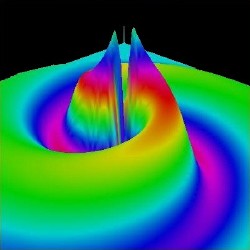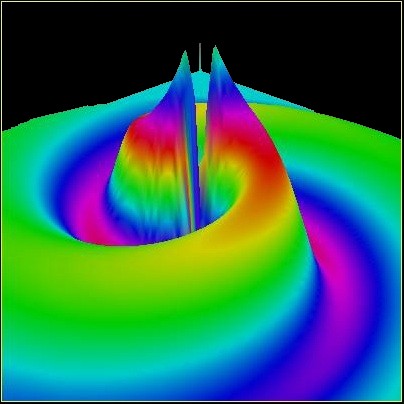Intergalactic Projectiles
When two black holes merge, they make waves–powerful gravitational waves. And if the merger spews these waves preferentially in one direction, it can shoot the merged hole the other way at high speed. In the 8 June issue of Physical Review Letters, two teams use computer simulations to show that the recoil speed for a pair of “supermassive” black holes could reach 4000 kilometers per second–ten times faster than previous estimates and fast enough to escape from even the biggest galaxy. Such a “black hole rocket” would be nearly invisible, but in some cases, according to a study in the 27 July Physical Review Letters, it might be observable if it brings enough material from the galaxy along with it.
Astrophysicists believe there is a supermassive black hole at the core of almost every galaxy, and when a pair of galaxies collides, their central black holes merge, too. The gravitational radiation emitted by the merger is usually in a preferred direction, giving the merged hole a “kick” in the opposite direction. Since the 1960s, astrophysicists have attempted to calculate the velocity of this recoil, but the complexity of the equations for general relativity has made it difficult to model spinning black holes or to deal with the extreme space-time distortions that appear during the final plunge. Computational techniques developed during the past two years allow much more precise simulations, and astrophysicists are now scrambling to calculate how fast the recoil could be.
Several papers in the past few months have reported recoils up to 500 kilometers per second. The “best-case scenario,” as several teams have found, includes two black holes of equal masses, rapidly spinning in opposite directions around parallel axes. But in a recent paper, David Merritt, Manuela Campanelli, and their colleagues, at the Rochester Institute of Technology in New York state suggested that if the spin axes were parallel–rather than perpendicular–to the orbital plane, very large kicks could result [1].
Bernd Brügmann and his colleagues at the University of Jena in Germany have now checked this idea and computed speeds of over 2500 kilometers per second. In the same issue of Physical Review Letters the Rochester researchers report that they adjusted the angle between the spin axis and the direction of motion for each hole to maximize the kick. Extrapolating their results to very fast spins, they got a whopping 4,000 kilometers per second, more than one percent of the speed of light.
“The surprise is that the top speeds are fast enough for the merged hole to escape its galaxy’s gravity,” Brügmann says. Such a “naked” black hole blasting through intergalactic space would be virtually invisible to astronomers, but the host galaxy might offer important clues, says Merritt. “The smoking gun would be a big galaxy with no black hole in its center.”
With a gas-rich galaxy, however, there is more hope of direct detection. Using mathematical arguments and some approximations, Abraham Loeb of Harvard University shows in another paper that an ejected black hole would have no difficulty taking its accretion disk along with it. “Most of the gas in the disk is moving close to the speed of light,” he says. “As far as it is concerned, the black hole is moving very slowly.” A gas-enveloped black hole could shine for up to 10 million years and travel as much as 30,000 light years–a third of a typical galaxy’s diameter–before vanishing from our sight, says Loeb.
Large kicks resulting in black hole ejections might be rare. “They seem to need fairly contrived initial conditions,” says Scott Hughes of the Massachusetts Institute of Technology. Although determining the maximum recoil velocity is important, Hughes says, “it would be more astrophysically relevant to map out what is typical–and that is going to take a lot more computation.”
–Chandra Shekhar
Chandra Shekhar is a freelance science writer in Princeton, New Jersey.
References
- M. Campanelli, C. Lousto, Y. Zlochower, and D. Merritt, “Large Merger Recoils and Spin Flips from Generic Black Hole Binaries,” Astrophys. J. 659, L5 (2007)
More Information
more movies of black hole mergers from the Rochester Institute of Technology





